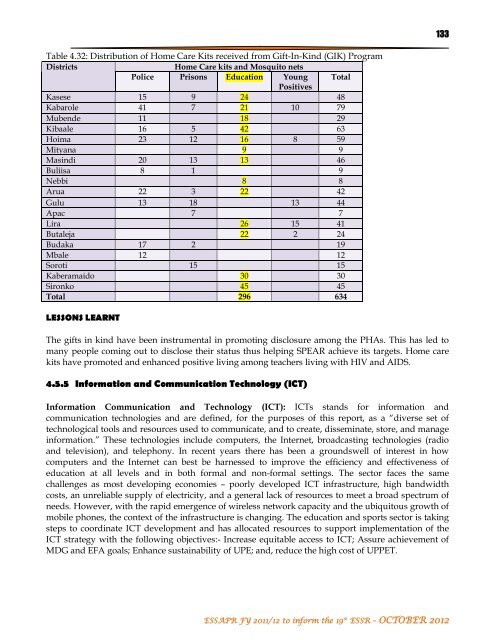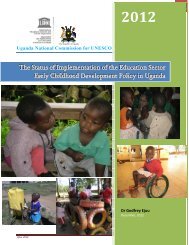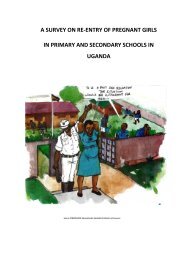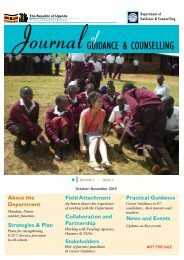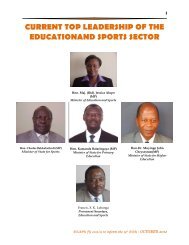Download Pdf - Ministry of Education and Sports
Download Pdf - Ministry of Education and Sports
Download Pdf - Ministry of Education and Sports
You also want an ePaper? Increase the reach of your titles
YUMPU automatically turns print PDFs into web optimized ePapers that Google loves.
133<br />
Table 4.32: Distribution <strong>of</strong> Home Care Kits received from GiftInKind (GIK) Program<br />
Districts<br />
Home Care kits <strong>and</strong> Mosquito nets<br />
Police Prisons <strong>Education</strong> Young Total<br />
Positives<br />
Kasese 15 9 24 48<br />
Kabarole 41 7 21 10 79<br />
Mubende 11 18 29<br />
Kibaale 16 5 42 63<br />
Hoima 23 12 16 8 59<br />
Mityana 9 9<br />
Masindi 20 13 13 46<br />
Buliisa 8 1 9<br />
Nebbi 8 8<br />
Arua 22 3 22 42<br />
Gulu 13 18 13 44<br />
Apac 7 7<br />
Lira 26 15 41<br />
Butaleja 22 2 24<br />
Budaka 17 2 19<br />
Mbale 12 12<br />
Soroti 15 15<br />
Kaberamaido 30 30<br />
Sironko 45 45<br />
Total 296 634<br />
LESSONS LEARNT<br />
The gifts in kind have been instrumental in promoting disclosure among the PHAs. This has led to<br />
many people coming out to disclose their status thus helping SPEAR achieve its targets. Home care<br />
kits have promoted <strong>and</strong> enhanced positive living among teachers living with HIV <strong>and</strong> AIDS.<br />
4.5.5 Information <strong>and</strong> Communication Technology (ICT)<br />
Information Communication <strong>and</strong> Technology (ICT): ICTs st<strong>and</strong>s for information <strong>and</strong><br />
communication technologies <strong>and</strong> are defined, for the purposes <strong>of</strong> this report, as a “diverse set <strong>of</strong><br />
technological tools <strong>and</strong> resources used to communicate, <strong>and</strong> to create, disseminate, store, <strong>and</strong> manage<br />
information.” These technologies include computers, the Internet, broadcasting technologies (radio<br />
<strong>and</strong> television), <strong>and</strong> telephony. In recent years there has been a groundswell <strong>of</strong> interest in how<br />
computers <strong>and</strong> the Internet can best be harnessed to improve the efficiency <strong>and</strong> effectiveness <strong>of</strong><br />
education at all levels <strong>and</strong> in both formal <strong>and</strong> nonformal settings. The sector faces the same<br />
challenges as most developing economies – poorly developed ICT infrastructure, high b<strong>and</strong>width<br />
costs, an unreliable supply <strong>of</strong> electricity, <strong>and</strong> a general lack <strong>of</strong> resources to meet a broad spectrum <strong>of</strong><br />
needs. However, with the rapid emergence <strong>of</strong> wireless network capacity <strong>and</strong> the ubiquitous growth <strong>of</strong><br />
mobile phones, the context <strong>of</strong> the infrastructure is changing. The education <strong>and</strong> sports sector is taking<br />
steps to coordinate ICT development <strong>and</strong> has allocated resources to support implementation <strong>of</strong> the<br />
ICT strategy with the following objectives: Increase equitable access to ICT; Assure achievement <strong>of</strong><br />
MDG <strong>and</strong> EFA goals; Enhance sustainability <strong>of</strong> UPE; <strong>and</strong>, reduce the high cost <strong>of</strong> UPPET.<br />
ESSAPR FY 2011/12 to inform the 19 th ESSR – OCTOBER 2012


